Munich, Germany
By Tracy A. Burns
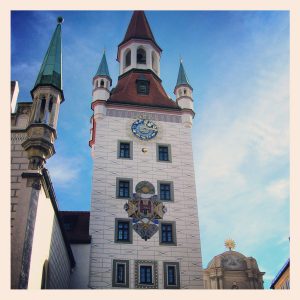 Perhaps the word most associated with Munich is beer. While the beer halls are definitely worth visiting, there is a lot more to Munich than merely that alcoholic beverage. You do not have to come here during Oktoberfest to enjoy the bustling, electric atmosphere. There are plenty of sights to explore as Munich is one of the cultural capitals of Europe, filled with museums, parks, palaces, and churches sure to dazzle any tourist.
Perhaps the word most associated with Munich is beer. While the beer halls are definitely worth visiting, there is a lot more to Munich than merely that alcoholic beverage. You do not have to come here during Oktoberfest to enjoy the bustling, electric atmosphere. There are plenty of sights to explore as Munich is one of the cultural capitals of Europe, filled with museums, parks, palaces, and churches sure to dazzle any tourist.
History of the city
Munich was founded in 1158 and has been the capital of Bavaria since 1503. The city flourished during the early 19th century when it made a name for itself in culture, arts, and science. In Munich, you’ll be sure to come across the name Wittelsbach. That dynasty ruled Bavaria from 1180 to 1918. However, Munich’s history is also punctuated with trials and tribulations. Both World War I and World War II brought tragedy to the city. Food shortages were common during World War I, and during World War II, the city became a center for the Nazi regime. Also, during World War II many buildings were heavily damaged or destroyed, though they have since been rebuilt and restored to their former glory.
Marienplatz and the New Town Hall
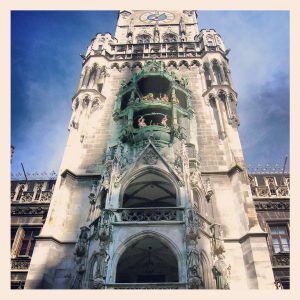 The main square of Marienplatz is the center of the city, where the 19th-century Gothic Revival New Town Hall dominates with its 100-meter-long main façade with 40 statues of Bavarian royalty. At the very top is a child dressed like a monk, called the Münchner Kindl, adopted as the city’s symbol. Now used as government administrative offices, the New Town Hall boasts a main tower that is 85 meters high and open to the public via an elevator.
The main square of Marienplatz is the center of the city, where the 19th-century Gothic Revival New Town Hall dominates with its 100-meter-long main façade with 40 statues of Bavarian royalty. At the very top is a child dressed like a monk, called the Münchner Kindl, adopted as the city’s symbol. Now used as government administrative offices, the New Town Hall boasts a main tower that is 85 meters high and open to the public via an elevator.
The Glockenspiel and Old Town Hall
A major source of entertainment on the square is the Glockenspiel, which puts on a show at 11 am and noon daily, sometimes also at 5 pm, depending on the time of the year. Knights joust, coppers dance, and a golden rooster crows three times. The Neo-Gothic Old Town Hall, renovated in the 19th century, was first erected in the 14th century. In its Grand Hall in November of 1938, high-ranking Nazi Joseph Goebbels gave a speech that led to Kristallnacht or the Night of the Broken Glass, a pogrom against Jews in Germany and Austria.
The Hofbräuhaus
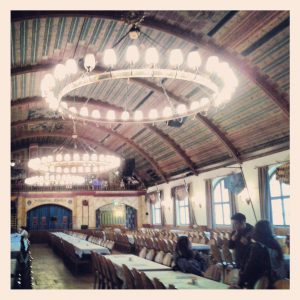 Built-in 1589, the Hofbräuhaus restaurant and beer garden draws a multitude of tourists and locals. Listen to traditional Bavarian music while drinking one of Munich’s finest beers and savoring a typical Bavarian meal. Wolfgang Amadeus Mozart claimed the time he spent in the Hofbrauhaus gave him inspiration for the opera Idomeneo. Vladimir Ilyich Lenin was a regular before World War I when he resided in the city. American President John F. Kennedy also tasted the fine brew here. Yet the beer hall has a very dark history as well. The Nazi Party often gathered here for meetings during World War II.
Built-in 1589, the Hofbräuhaus restaurant and beer garden draws a multitude of tourists and locals. Listen to traditional Bavarian music while drinking one of Munich’s finest beers and savoring a typical Bavarian meal. Wolfgang Amadeus Mozart claimed the time he spent in the Hofbrauhaus gave him inspiration for the opera Idomeneo. Vladimir Ilyich Lenin was a regular before World War I when he resided in the city. American President John F. Kennedy also tasted the fine brew here. Yet the beer hall has a very dark history as well. The Nazi Party often gathered here for meetings during World War II.
The Residence Museum
The largest city palace in Germany, the Residence Museum is sure to amaze with its 90 lavish rooms and eight-room treasury. The tour starts off with a bang in the Grotto Courtyard, built around 1584 and decorated with stalactite and stalagmite shapes set with colorful shells and crystals. The Hall of Antiquities is the largest Renaissance hall north of the Alps with sculptures and 16 ceiling paintings of Bavarian towns and markets.
More rooms at the Residence Museum
Take the long route, so you do not miss the Trier Rooms with stunning tapestries celebrating the months of the year. The blue-and-gold painted glass windows of the Ornate Chapel, hailing from 1607, are bewitching. The holy room is decorated with Albrecht Dürer’s scenes from the life of the Virgin Mary. The Ancestral Gallery is flanked by Rococo portraits of more than 100 members of the Wittelsbach clan, who had the palace built.
The Cuvilliés Theatre
Also in the Residence Museum complex, the Cuvilliés Theatre, which once served as the court theatre, is pure Rococo in red and gold. It was designed by François de Cuvilliés and built from 1751 to 1753. Take a long look at those carved and gilded loges.
Frauenkirche
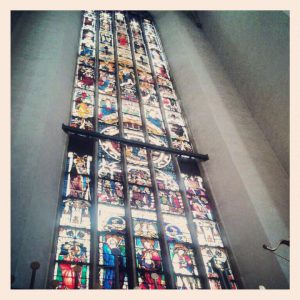 There are many churches worth visiting in Munich, too. With a two-tower façade, the Church of Our Lady or Frauenkirche is imposing. Designed in a Gothic style that goes back to the 1400s, the church has one nave and two side aisles. It is home to the lavish black marble tomb of Ludwig the Bavarian, who died in 1347. Check out its fantastic sculptural adornment. Exquisite stained glass windows and a Late Gothic pietà are other highlights.
There are many churches worth visiting in Munich, too. With a two-tower façade, the Church of Our Lady or Frauenkirche is imposing. Designed in a Gothic style that goes back to the 1400s, the church has one nave and two side aisles. It is home to the lavish black marble tomb of Ludwig the Bavarian, who died in 1347. Check out its fantastic sculptural adornment. Exquisite stained glass windows and a Late Gothic pietà are other highlights.
St. Michael’s Church and St. Peter’s Church
The Jesuit Church of St. Michael hails from the 16th century and is the largest Renaissance church north of the Alps. It has a Baroque main altar with three tiers. The ceiling is captivating for its barrel vaulting. The ornate reliquary shrine with statuary holds the heads of Saints Cosmas and Damian. St. Peter’s Church has two high altars – a Baroque one and a late Gothic one. Stucco ornamentation, frescoes, and Rococo decoration make this church a must-see.
The Assam Church
Created by the Assam brothers, the Assam Church dedicated to Czech saint John Nepomuk is gushing with late Baroque and Rococo decorations. The ceiling fresco deals with the life and martyrdom of St. John Nepomuk, who was drowned in the Vltava River and even boasts a portrayal of Prague’s St. Vitus Cathedral. Pillars, statues, reliefs, and large paintings will amaze.
Nymphenburg Palace
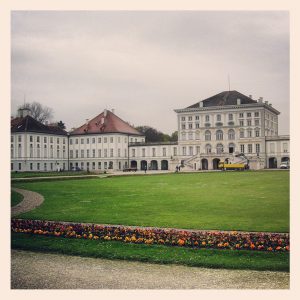 Once the summer palace of Bavarian kings, Nymphenburg Palace is a short tram ride away from the center. Ludwig I’s Gallery of Beauties, the Rococo banqueting hall, and the Bedroom of the Electress with its green damask on the walls are just a few of the interior highlights. Yet even more impressive is the Classical landscaped park, which includes architecturally fascinating buildings, fountains, a big lake, and sculptures. One of the park’s wonders, the Amalienburg Rococo hunting lodge with its spectacular Hall of Mirrors was created by Francois de Cuvilliés the Elder in the middle of the 18th century. The Marshall Museum boasts one of the largest collections of royal carriages and sleighs in Europe and also hosts an exhibition of Nymphenburg porcelain.
Once the summer palace of Bavarian kings, Nymphenburg Palace is a short tram ride away from the center. Ludwig I’s Gallery of Beauties, the Rococo banqueting hall, and the Bedroom of the Electress with its green damask on the walls are just a few of the interior highlights. Yet even more impressive is the Classical landscaped park, which includes architecturally fascinating buildings, fountains, a big lake, and sculptures. One of the park’s wonders, the Amalienburg Rococo hunting lodge with its spectacular Hall of Mirrors was created by Francois de Cuvilliés the Elder in the middle of the 18th century. The Marshall Museum boasts one of the largest collections of royal carriages and sleighs in Europe and also hosts an exhibition of Nymphenburg porcelain.
The Alte Pinakothek and the Neue Pinakothek
There are plenty of museums to visit as well. The Alte Pinakothek is home to 700 works of European painting from the 14th to the 18th centuries. Dürer, Peter Paul Rubens, Jan Brueghel the Elder, and Raphael are just a few of the artists represented. Keep in mind that renovation is taking place from 2014 to 2017, and some sections of the museum are closed. See www.pinakothek.de for more information. The Neue Pinakothek shows off 400 paintings and sculptures from the 19th century, ranging from Classicism to French Impressionism.
The Pinakothek der Moderne, the Lenbachhaus and the Deutsches Museum
The Pinakothek der Moderne includes 20th and 21st-century art and design. The basement exhibition of computers and furnishings from the 20th century is particularly intriguing. If you are a fan of Wassily Kandinsky, August Mache, Paul Klee, and Franz Marc, do not miss the world’s largest collection of art of the Blue Rider movement in the early 20th century with its colorful, vibrant canvases at the Lenbachhaus. The Deutsches Museum is perfect for those interested in science and technology, as exhibits range from the Stone Age to the present and take up eclectic themes such as mining and atomic physics. Other museums focus on Egyptian art and Greek and Roman antiquities, for instance.
Other sights to visit
Don’t miss Dallmayr Delicatessen for a superb selection of seafood, chocolate, coffee, tea, and sweets. Head upstairs to the traditional German café to eat delicious cake and try the tasty coffee. Sample the food at the Viktualienmarkt, a large, bustling open-air market in the center. Relax in the English Garden while it is bursting with color in the spring and summer.




